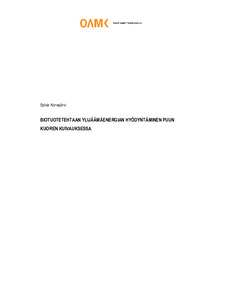Biotuotetehtaan ylijäämäenergian hyödyntäminen puun kuoren kuivauksessa
Korvajärvi, Sylvia (2023)
Korvajärvi, Sylvia
2023
All rights reserved. This publication is copyrighted. You may download, display and print it for Your own personal use. Commercial use is prohibited.
Julkaisun pysyvä osoite on
https://urn.fi/URN:NBN:fi:amk-2023052915230
https://urn.fi/URN:NBN:fi:amk-2023052915230
Tiivistelmä
Opinnäytetyön tavoitteena oli selvittää sellutehtaalla syntyvän kuoren kuivaamista ja kuivauksesta saatavia hyötyjä. Kuoren kuivaaminen toteutetaan hyödyntäen ylijäämälämpöä sekä höyryä. Työssä selvitettiin eri kuivausmenetelmien käyttökelpoisuutta sekä arvioitiin kuivauksen kustannuksia ja kuivauksella saavutettavaa lisäarvoa.
Työn toimeksiantaja oli Kaicell Fibers Oy, joka suunnittelee biotuotetehtaan perustamista Paltamoon. Toimeksiantaja halusi selvittää kuoren kuivaamisen hyötyjä sekä myös investointikustannuksia. Investointikustannuksien laskennassa käytettiin annuiteettilainamenetelmää, jossa korkona käytettiin 5 % ja laina-aikana 20 vuotta.
Kuorta syntyy biotuotetehtaan prosessissa paljon ja sille täytyi löytää jatkosuunnitelma. Kuoren kuivurin investoiminen on myös välttämätön prosessin meesauunin polttoaineena toimivan kuoren kuivaamisessa. Työssä kuitenkin käsiteltiin pääasiassa ylijäämäkuoren kuivaamista, joka on suunniteltu myytävän polttoaineeksi kaukolämmön tuotantoon. Kuivaamisen kustannukset aiheutuvat pääasiassa kuoren kuljetuksesta, sillä välimatkaa laitoksien välillä on 40 km. Työssä käsiteltiin myös kuoren kuivaamisesta aiheutuviin päästöihin.
Kun kuivaamisesta saatavia hyötyjä ja kustannuksia laskettiin yhteen, saatiin kuivauksen järjestämisestä taloudellisesti kannattavaa. Kuoren kuivaamisen avulla sen taloudellinen arvo kasvaa, sillä kuoren lämpöarvo kasvaa. Kuljetuskustannukset myös pienenevät kuivaamisen ansiosta, sillä kuori sisältää kuivattuna paljon vähemmän vettä kuin märkä kuori. The aim of the thesis was to find out the drying of the bark produced at the pulp mill and the benefits of drying. Drying of the shell is carried out using surplus heat and steam. The work investigated the usability of different drying methods and evaluated the costs of drying and the added value achieved by drying.
The client of the work was Kaicell Fibers Oy, which plans to establish a bioproduct factory. The client wanted to find out the benefits of drying the bark and the investment costs. The annuity loan method was used in the calculation of investment costs, where the interest rate was 5% and the loan period was 20 years.
A lot of bark is produced in the bioproduct factory process, and a follow-up plan had to be found for it. Investing in a bark dryer is also necessary for drying the bark that serves as fuel for the lime kiln in the process. However, the work mainly dealt with drying the surplus bark, which is designed to be sold as fuel to produce district heat. The costs of drying are mainly caused by the transportation of the bark, as the distance between the plants is 40 kilometers. The work also dealt with the emissions caused by drying the bark.
When the benefits and costs of drying were added up, organizing the drying was economically profitable. By drying the bark, its economic value increases, as the calorific value of the bark increases. Transport costs are also reduced thanks to drying, as dried bark contains much less water than wet bark.
Työn toimeksiantaja oli Kaicell Fibers Oy, joka suunnittelee biotuotetehtaan perustamista Paltamoon. Toimeksiantaja halusi selvittää kuoren kuivaamisen hyötyjä sekä myös investointikustannuksia. Investointikustannuksien laskennassa käytettiin annuiteettilainamenetelmää, jossa korkona käytettiin 5 % ja laina-aikana 20 vuotta.
Kuorta syntyy biotuotetehtaan prosessissa paljon ja sille täytyi löytää jatkosuunnitelma. Kuoren kuivurin investoiminen on myös välttämätön prosessin meesauunin polttoaineena toimivan kuoren kuivaamisessa. Työssä kuitenkin käsiteltiin pääasiassa ylijäämäkuoren kuivaamista, joka on suunniteltu myytävän polttoaineeksi kaukolämmön tuotantoon. Kuivaamisen kustannukset aiheutuvat pääasiassa kuoren kuljetuksesta, sillä välimatkaa laitoksien välillä on 40 km. Työssä käsiteltiin myös kuoren kuivaamisesta aiheutuviin päästöihin.
Kun kuivaamisesta saatavia hyötyjä ja kustannuksia laskettiin yhteen, saatiin kuivauksen järjestämisestä taloudellisesti kannattavaa. Kuoren kuivaamisen avulla sen taloudellinen arvo kasvaa, sillä kuoren lämpöarvo kasvaa. Kuljetuskustannukset myös pienenevät kuivaamisen ansiosta, sillä kuori sisältää kuivattuna paljon vähemmän vettä kuin märkä kuori.
The client of the work was Kaicell Fibers Oy, which plans to establish a bioproduct factory. The client wanted to find out the benefits of drying the bark and the investment costs. The annuity loan method was used in the calculation of investment costs, where the interest rate was 5% and the loan period was 20 years.
A lot of bark is produced in the bioproduct factory process, and a follow-up plan had to be found for it. Investing in a bark dryer is also necessary for drying the bark that serves as fuel for the lime kiln in the process. However, the work mainly dealt with drying the surplus bark, which is designed to be sold as fuel to produce district heat. The costs of drying are mainly caused by the transportation of the bark, as the distance between the plants is 40 kilometers. The work also dealt with the emissions caused by drying the bark.
When the benefits and costs of drying were added up, organizing the drying was economically profitable. By drying the bark, its economic value increases, as the calorific value of the bark increases. Transport costs are also reduced thanks to drying, as dried bark contains much less water than wet bark.
